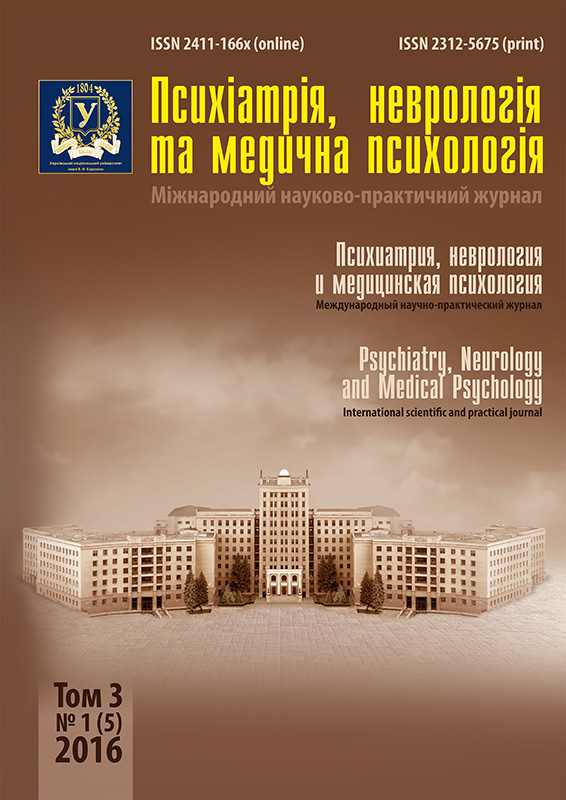Застосування анімалотерапії у дітей з розладами аутистичного спектру
Анотація
В останні роки значно зросла кількість дітей з розладами аутистичного спектру. Сім’ї дітей з аутизмом часто проводять різні втручання в надії полегшити стан дітей з розладами аутистичного спектру. Психосоціальна реабілітація за допомогою тварин визначається як використання тварини для забезпечення терапевтичного ефекту, заснованого на позитивному зв’язку між клієнтом і твариною, що служить альтернативним варіантом терапії дітей з розладом аутистичного спектру. Використовувана на базі Центру психосоціальної реабілітації дітей та підлітків «Фельдман Екопарк» анімалотерапія для дітей з розладами аутистичного спектру забезпечує ряд перспектив для благополуччя дитини: психологічний, соціальний і технічний аспекти. У статті описано поєднання нових для України методів реабілітації дітей з аутизмом: іппотреапія і каністерапія. Результати цього дослідження свідчать про те, що комбінування іпотерапії та каністерапії може мати широкий спектр терапевтичних переваг для дітей з розладами аутистичного спектру. Така програма є унікальною формою терапії, так як може вплинути на різні галузі фізичного і психологічного функціонування дітей.
Завантаження
Посилання
National Information Mental Health. Autism spectrum disorder (statistics). Retrieved January, 2001, no. 18.
American Psychiatric Association. Diagnostic and statistical manual of mental disorders, 5th ed., Arlington, VA, American Psychiatric Publishing, 2013.
Centers for Disease Control and Prevention. Autism spectrum disorder: Facts about ASD, 2014.
Davis T. N., O’Reilly M., Kang S., Lang R., Rispoli M., Sigafoos J., Mulloy A. Chelation treatment for autism spectrum disorders: A systematic review. Research in Autism Spectrum Disorders, 2013, no. 7, pp. 49-55.
Green V. A., Pituch K. A., Itchon J., Choi A., O’Reilly M., Sigafoos J. Internet survey of treatments used by parents of children with autism. Research in Developmental Disabilities, 2006, no. 27, pp. 70-84.
Heflin L. J., Simpson R. L. Interventions for children and youth with autism: Prudent choices in a world of exaggerated claims and empty promises. Part I: Intervention and treatment option review. Focus on Autism and Other Developmental Disabilities, 1998, no. 13, pp. 194-211.
Mulloy A., Lang R., O’Reilly M., Sigafoos J., Lancioni G., Rispoli M. Gluten-free and casein-free diets in the treatment of autism spectrum disorders: A systematic review. Research in Autism Spectrum Disorders, 2010, no. 4, 328-339.
Sams M. J., Fortney E. V., Willenbring S. Occupational therapy incorporating animals for children with autism: A pilot investigation. The American Journal of Occupational Therapy, 2006, no. 60, 268-274.
Silva K., Correia R., Lima M., Magalhaes A., De Sousa L. Can dogs prime autistic children for therapy? Evidence from a single case study. The Journal of Alternative and Complementary Medicine, 2011, no. 17, pp. 655-659.
Solomon O. What a dog can do: Children with autism and therapy dogs in social interaction. Ethos, 2010, no. 38, pp. 143-166.
Palley L. S., O’Rourke P. P., Niemi S. M. Main-streaming animal-assisted therapy. ILAR Journal, 2010, no. 51, pp. 199-207.
Esposito L., McCardle P., Maholmes P., McCune S., Griffin J. A. Introduction. Animals in our lives: Human-animal interaction in family, community, and therapeutic settings [eds. P. McCardle, S. McCune, J. A. Griffin, L. Es-posito, & L. S. Freund]. Baltimore, MD, Brookes Publishing Co., 2011, pp. 1-5.
Kruger K. A., Serpell A. Animal-assisted interventions in mental health. Handbook on animalas sisted therapy: Theoretical foundations and guidelines for practice [ed. A. H. Fine] 3rd ed., San Diego, CA: Academic Press, 2010, pp. 33-48.
Breitenbach E., Stumpf E., Fersen L. V., Ebert H. Dolphin-assisted therapy: Changes in interaction and communication between children with severe disabilities and their caregivers. Anthrozoo ̈s, 2009, no. 22, pp. 277-289.
Bass M. M., Duchowny C. A., Llabre M. M. The effect of therapeutic horseback riding on social functioning in children with autism. Journal of Autism and Developmental Disorders, 2009, no. 39, pp. 1261-1267.
Burrows K. E., Adams C. L., Millman S. T. Factors affecting behavior and welfare of service dogs for children with autism spectrum disorder. Journal of Applied Animal Welfare Science, 2008, no. 11, pp. 42-62.
Dingman A. Hoof prints: Equine therapy for au-tistic children. Encounter, 2008, no. 21(4), pp. 11-13.
Memishevikj H., Hodzhikj S. The effects of equine-assisted therapy in improving the psychosocial functioning of children with autism. Journal of Special Education and Rehabilitation, 2010, no. 11, pp. 57-67.
Pawlik-Popielarska B. M. The impact of kyno-therapy in handicapped children. Acta Neuropsychologica, 2010, no. 8, pp. 26-37.
Maurer M., Delfour F., Wolff M., Adrien J. Dogs, cats and horses: Their different representations in the minds of typical and clinical populations of children. Anthrozoo ̈s, 2010, no. 2, 383-395.
Bush C. T. Excerpts From the Report of the Surgeon General’s Conference on Children’s Mental Health: A National Action Agenda. Journal of Child and Adoles-cent Psychiatric Nursing, 2001, no. 14(2), pp. 94-95.
Martin F., Farnum J. Animal-assisted therapy for children with pervasive developmental disorders. Western Journal of Nursing Research, 2002, no. 24, pp. 657-670.
Авторське право (c) 2016 B. V. Mykhaylov, M. E. Vodka, I. D. Vashkite, T. A. Aliieva

Цю роботу ліцензовано за Міжнародня ліцензія Creative Commons Attribution 4.0.




